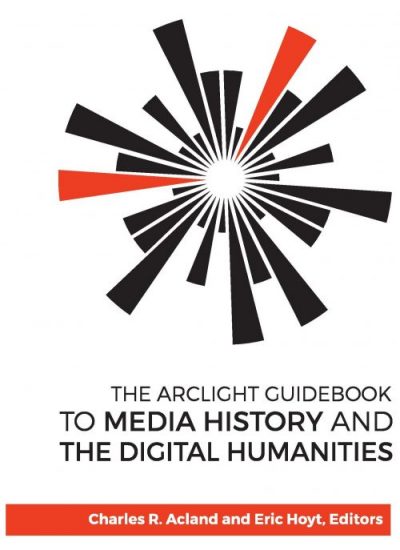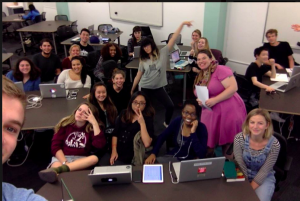This is an edited version of a talk I gave at UC Irvine on February 5, at a symposium organized by Peter Krapp and Geoffrey Bowker.
Digital humanities, as we all know, is sexy right now. It seems to be everywhere, including the New York Times, the New Republic, and the Atlantic. Mellon’s funding it, the NEH is funding it, ACLS is funding it, we’re telling our grad students to prepare to work in it. Digital humanities initiatives or centers are popping up everywhere, and what a luxury to be part of a field that’s so frequently mentioned that people create angry memes about it.
At UCLA, I run and teach in our digital humanities minor and graduate certificate, which started four years ago and now enrolls about 60 undergraduates and 30 graduate students. Students are genuinely excited about DH, and it is a total blast for me to work with them to chart out the possibilities of this expanding field.
University departmental structures aren’t always congenial to interdisciplinary work, but students seem to get it right away. They’re really fascinated by the basic questions DH raises about knowledge organization, history, and epistemology, and I love the way they push the field’s boundaries just by asking the questions that come most naturally to them. I’ve felt actually extremely lucky to be part of a field that’s growing so quickly, and even to be in a position to help chart its direction.
But all this excitement and energy might conceal some less exciting ground truths. I have been spending a ton of time on the road lately, meeting with people who are starting DH centers and talking with people who are keeping initiatives and centers going. And they are tired. They are all really tired.
And once you drill down into the specific staffing and labor configurations of these DH initiatives, you’ll begin to see why. So many of these programs are staffed entirely by postdocs, perhaps with a faculty director who spends a portion of his or her time running the center.
In other cases, a DH initiative consists of a single librarian, who’s probably also responsible for liaising with several academic departments. If a DH initiative has programmers, they’re usually what you’d call “matrixed,” meaning they have multiple bosses, to whom they have to account for their time in exquisite detail. Or if the DH activity is coming from faculty, it’s from people who have to use every ounce of their ingenuity to scare up resources to support their students and their research.
Why is this widespread shortstaffing happening? Some of it is probably just because DH is new and untested, and it is notoriously difficult to launch new, interdisciplinary programs at universities, especially big ones like most of the UCs.
And DH has had the bad timing to emerge during a moment of particular budget austerity, at least when it comes to paying for academic programs. (Whether that’s coincidental is another, much longer discussion.) Launching a program with a two-year postdoc is clearly absurd and shortsighted, but it’s nevertheless become standard operating procedure for many places looking to get a program going. So, in a way, many of these conditions are just typical of our corner of academia at our current moment.
I wonder, though, if part of the problem might also be that our institutions have absorbed some of the widespread rhetoric about the immateriality of digital labor. We’ve come to think that stuff that you do on a computer can be done anywhere, anytime — and thus everywhere, all the time, with no particular material requirements.
We’re used to getting digital stuff for free, from Facebook to iPhone apps, so perhaps we think digital academic programs shouldn’t be any different. People built Linux for free; why shouldn’t they donate their time to build a DH program?
The wide availability of free software and the general enthusiasm about all things digital have probably contributed to this notion that all we need to make a DH center is a laptop and a postdoc. For my part, I’ve optimized absolutely everything about my job I can possibly optimize, from text-expanders and email auto-filters to IFTTT pipelines to automatic appointment-booking software. We’re all lifehacking, right? And I still feel like I’m teetering on the brink of burnout.
Don’t worry, this isn’t really about me. I mean, we should all be concerned with every laborer’s working conditions, and we should all be concerned about what’s happening with academic labor. I suspect we all are. But I actually want to make a somewhat different argument here, one that has more to do with the possible futures of both of our fields.
Recently, I was talking to a group of our grad students about the kinds of work people are doing right now in digital humanities, and they asked some uncomfortable questions.
Take digital mapping. Postcolonial theorists have known since forever that the Mercator projection enshrines Western European, Cartesian models of space, when in fact there are many different ways of understanding geography. Why does every DH project use the Mercator projection?
Or take network analysis software. The tools we tend to use, like Gephi and Cytoscape, are great at measuring centrality and clustering coefficients. But what about some of the most basic things a humanist might like to do, like transforming the network diagram to reflect the perception of a different historical actor? That’s just not a possibility for us. Why is that?
Why? It’s simple. Because we’re relying on tools and infrastructure built for industry — or, in the best cases, for scientists. Which makes a certain amount of sense; one doesn’t want to reinvent the wheel. But it’s also had material effects on the kind of work we can produce, and the horizons of possibility our work can open. When we choose not to invest in our own infrastructure, we choose not to articulate a different possible version of the world.
In fact, this state of affairs is already very well-documented for edtech. By outsourcing development of key components of educational technology to for-profit vendors, we’ve chosen to invest in the development of software companies that mine our students’ data, encourage us to spy on their work, and lock us into a closed ecosystem of for-profit technology whose philosophy bears very little resemblance to the kinds of teachers we started out wanting to be.
And for all of the excitement about grant funding opportunities and enthusiastic administrators, the actual state of DH funding is less flush-with-cash than boom-and-bust. An NEH grant, no matter how prestigious, doesn’t secure a salary for very long. A postdoc, no matter how smart and committed, isn’t going to singlehandedly change campus culture.
It’s one thing to get an awesome project going; it’s another thing to pay for the routine maintenance necessary to keep it up and running. Recently, we saw the closure of HyperCities, UCLA’s well-known mapping platform for humanistic projects. People were tired of piecing together grant funding to keep it lurching along. Meanwhile, Google decided to shut down its support for the Google Earth browser plugin, so … it’s gone. That’s what happens when we don’t invest in our own infrastructure.
Don’t get me wrong, I get tired all the time of trying to wrestle with the exhausting bureaucracy of a public school, and I’ve turned to private-industry solutions plenty of times. Most recently, I’ve given up on trying to control my own space on university servers and started encouraging my students to purchase their own space from hosting companies for class projects.
It seems like the reasonable thing to do, since Lord knows I’ve had my stuff written over and erased from university servers more times than I can count. But I’m also aware that by choosing not to invest in support for this kind of thing, we’re relinquishing all of this work to private servers. We’ll never get it back again.
Last year, UCLA announced an app competition. The contest promised a $5,000 prize for the best app to, quote, promote “UCLA’s mission of education, research and service.” I’m 100% sure that the offices that sponsored this contest had the best intentions, and I salute the winners. But this is not support. This is not research support. How long does it take to build an app? How many people does it take? How is the app going to get updated once the contest is over? What message are we sending our students by telling them they should work for free? Has anyone thought this through?
We want to believe that we can be agile and innovative, like Silicon Valley says it is, by making DH run with short-term grants, app contests, and temporary labor. We want to have a sort of Uber-style sharing economy for DH-research. But this is not how one supports careful, enduring scholarship and teaching.
Why does digital humanities look the way it does right now? I think the boom-and-bust cycle of grant-chasing and temporary funding has had a huge but largely unacknowledged effect on the kind of scholarship we’re producing. If we want to produce truly challenging scholarship and keep our best scholars from burning out, we need to pressure our institutions to, frankly, pay up. You can optimize, streamline, lifehack, and crowdsource almost everything you do — but good scholarship still takes money and time.







